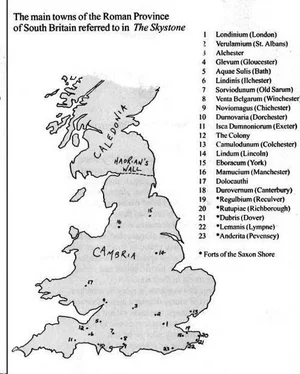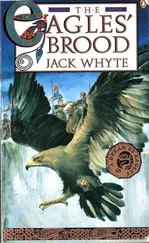THE SKYSTONE
Jack Whyte
Whyte was born in Scotland and came to Canada in 1967. An actor, orator, singer and poet, his narrative poetry earned him two gold medals at the prestigious New York International Film Festival in 1991 for Best Writing and Best Narration. Jack Whyte's critically acclaimed A Dream of Eagles cycle includes the titles
The Skystone, The Singing Sword, The Eagles' Brood, The Saxon Shore,
and
The Sorcerer
Books I and II:
The Fort at River's Bend and Metamorphosis.
Copyright © Jack Whyte, 1992 All rights reserved.
Publisher's note: The Skystone is based in part on actual events, but all the principal characters are fictional.
To my wife Beverley,
who always believed,
but now can't, quite.
INTRODUCTORY NOTE
The term "historical fiction" indicates that there is at least a framework of factual material involved in the story being told in a novel. It seems to follow, therefore, that everyone who reads historical fiction should have a right to know — or should be accorded the privilege of knowing — how much of what he or she is reading is historically correct and accurate.
The characters Caius Britannicus and Publius Varrus are fictitious, as are all their families, friends and relatives. They were all born of the author’s need to answer the question, "How could this, or that, have happened or come into being?"
The events against which their fictional story unfolds, however, were very real, and the major imperial characters — Valens, Valentinian, Theodosius and Stilicho — lived and behaved as described herein. The time in which they lived, the latter part of the fourth and the early part of the fifth Christian centuries, was a period when world-shaking events took place; things that still affect our lives today,. sixteen hundred years afterward, owe their beginnings to the ideas and events that were developing at that time.
The eighty-one-year period from 367 to 448 AD was among the most intense in the history of the province the Romans called Britain. At the start of it, in 367, Britain was still firmly Roman, and the Roman authorities still maintained written records. By the end of it, however, the four-hundred-year occupation of Britain had ended, the entire Roman Empire in the West was in ruins, and Britain itself, the western Empire’s richest granary, had been so thoroughly conquered by the Angles and Saxons that it would be known forever afterward as the land of the Angles — England.
In the space of those eighty years, civilized life, literacy, education and Christianity were stamped out and the Dark Ages settled on Britain. They would last for two centuries and more, so that by the time the light of learning returned to Britain, great changes had been wrought, and legends had been born. The English longbow was then a fact of life, and people talked on long, dark, winter nights of a great champion who had led his people valiantly in ancient times, armed with a magic sword he had received from a woman's hand. It was the beginning of what would come to be known, over the course of centuries, as the Arthurian Legend. The Roman Army,
The differences between the Roman army of antiquity and the modern army are differences mainly of names. The structures are comparable. A modern Army Group, or a Brigade, made up of several regiments, is the approximate equivalent of a classic Roman legion. The officer commanding the modern Brigade is a Brigadier General, and he is assisted by an adjutant or deputy, plus a staff of senior officers made up of the Colonels and Majors of each regiment. These are assisted in run by their company commanders (Captains) and subalterns (Lieutenants),who are backed up by their non-commissioned officers. In the Roman army, the commanding officer of a legion was called the Legate. He was assisted by an adjutant or deputy called the Camp Prefect, and a staff of six senior administrative officers called Tribunes. The original function of the Tribunes was to spread the call to arms and ensure that the citizens rallied to the Eagles in time to march and fight. Later, the Tribunate became more of a political tenure, a training ground for young noblemen waiting to go into the consular or civil services. Whenever a Tribune chose to distinguish himself militarily rather than serve his time administratively and get out, his success was almost preordained.
There were normally twenty-eight legions in commission at any given time, and each legion was divided into ten cohorts. By the end of the third century, the first two cohorts of each legion had been expanded to Millarian status, which meant that each held 1,000 men and was the approximate equivalent of a modern battalion. Prior to that time, only the First Cohort had been Millarian. To the First and Second Cohorts fell the honour of holding the right of the legion's line of battle, and they were made up of only the finest and strongest battle-hardened veterans. Cohorts Three through Ten were standard cohorts of 500 to 600 men. Each Millarian cohort was composed of ten maniples, and a maniple was made up of ten squads of ten to twelve men each.
The bulk of the legion's command was provided by the Centuriate, from the ranks of which came the centurions, all the middle-and lower-ranking commissioned officers of the legion. There were six centurions to each cohort from Three through Ten, making forty-eight, and five senior centurions, called primi ordines, in each of the two Millarian Cohorts. Each legion had a primus pilus, the senior centurion, a kind of super-charged Regimental Sergeant Major. The primus pilus headed the First Cohort, the Second Cohort was headed by the princeps secundus, and Cohorts Three through Ten were each commanded by a pilus prior.
The Roman centurion was distinguished by his uniform: his armour was silvered, he wore his sword on his left side rather than his right, and the crest on his helmet was turned so that it went sideways across his helmet like a halo.
Each centurion had the right, or the option, to appoint a second-in-command for himself, and these men, the equivalents of non-commissioned officers, were known for that reason as optios. Other junior officers (princi-pales) were the standard-bearers, one of whom, the aquilifer, bore the Eagle of the legion. There was also a signifer for each century, who bore the unit's identity crest and acted as its banker. Each legion also had a full complement of physicians and surgeons, veterinarians, quartermasters and clerks, trumpeters, guard commanders, intelligence officers, torturers and executioners. Cavalry.
By the end of the second century AD, cavalry was playing an important role in legionary tactics and represented up to one-fifth of overall forces in many military actions.
Nevertheless, until the turn of the fifth century, the cavalry was the army’s weakest link.
The Romans themselves were never great horsemen, and Roman cavalry was seldom truly Roman. They preferred to leave the cavalry to their allies and subject nations, so that history tells us of the magnificent German mixed cavalry that Julius Caesar admired, and which gave rise to the cohortes equitates, the mixed cohorts of infantry and cavalry used in the first, second and third centuries AD. Roman writers also mention with admiration the wonderful light horsemen of North Africa, who rode without bridles.
Fundamentally, with very few exceptions, cavalry were used as light skirmishing troops, mainly mounted archers whose job was patrol, reconnaissance and the provision of a mobile defensive screen while the legion was massing in battle array.
Roman cavalry of the early and middle Empire was organized in alae, units of 500 to 1,000 men divided into squadrons, or turmae, of 30 or 40 horsemen under the command of decurions. We know that the Romans used a kind of saddle, with four saddle horns for anchoring baggage, but they had no knowledge of stirrups, although they did use spurs. They also used horseshoes and snaffle bits, and some of their horses wore armoured cataphractus blankets of bronze scales, although there is little evidence that this form of armour, or armoured cavalry, was ever widely used.
Читать дальше









